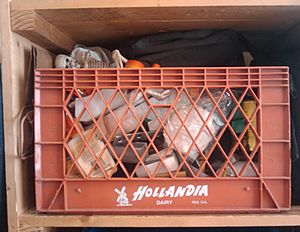Thermoplastic facts for kids
A thermoplastic is a special kind of material, usually a plastic called a polymer. Think of it like a chocolate bar: when you heat it up, it gets soft and melts into a liquid. But when it cools down, it becomes hard again. The cool thing about thermoplastics is that you can heat them up and cool them down many times, and they won't change their basic properties. This means they can be melted and reshaped over and over!

When thermoplastics are heated to their melting point, they turn into a liquid. When they cool down below a certain temperature, called their glass transition temperature, they become solid and glassy.
Thermoplastics are used in many different products. For example, some are used in electronics to protect devices from things like static electricity and radio frequency interference. They are one of the two main kinds of plastics.
Thermoplastics can be moulded (shaped) into almost any form you can imagine. They are different from another type of plastic called thermosetting polymers. Thermosets, once they are heated and set, form strong, permanent chemical bonds. This means they can't be melted and reshaped again like thermoplastics.
Contents
What are the main types of plastics?
There are several common types of thermoplastics you might see every day:
PET (Polyethylene Terephthalate)
PET is a lightweight plastic that can be either stiff or a bit flexible. It's naturally clear or colorless. PET is great at keeping moisture and gases out, and it's strong against impacts. It's one of the easiest plastics to recycle! You'll find PET in water bottles, plastic bags, and even in synthetic fibers used for clothing.
HDPE (High-Density Polyethylene)
HDPE is strong and easy to work with. It's not completely clear, but a bit see-through. It's also resistant to impacts and is safe to use. HDPE is often used to make sturdy bottles, large tanks, bins, and containers for shipping things.
LDPE (Low-Density Polyethylene)
LDPE can be clear or see-through. It's the lightest and most sensitive to heat among these plastics. It's safe for contact with food. LDPE is used for packaging, shopping bags, trash bags, coatings for cables, and even toys.
PVC (Polyvinyl Chloride)
PVC is a very flexible plastic. It's tough and resistant to wear and tear, chemicals, weather, and even fire. PVC is used in many places, like in the paper industry, for packaging, food containers, credit cards, furniture, some clothing, and toys.
PP (Polypropylene)
PP is clear, light, and strong. It can be used as both a plastic and a fiber. It's easy to color and doesn't absorb water. You'll find PP in textile fibers, car parts, containers for transport, furniture, carpets, ropes, and food containers.
PS (Polystyrene or Styrofoam)
PS is a very important thermoplastic. It's clear, hard, and doesn't easily catch fire. It's also very shiny and doesn't react with many harsh chemicals. It can be made in shiny or dull colors. Polystyrene is often used instead of glass, aluminum, or wood because it's cheaper. It's also used in packaging (including for food), containers, boxes, lamps, disposable items, cups, and toys.
Related pages
Images for kids
See also
 In Spanish: Termoplástico para niños
In Spanish: Termoplástico para niños


